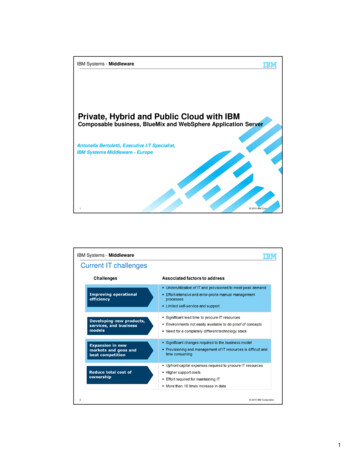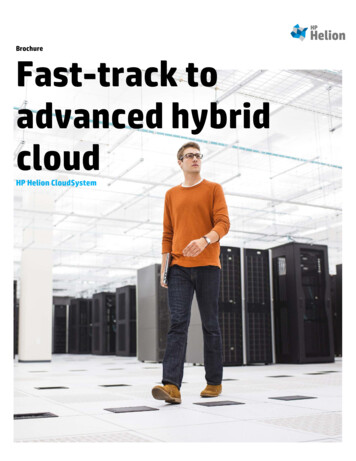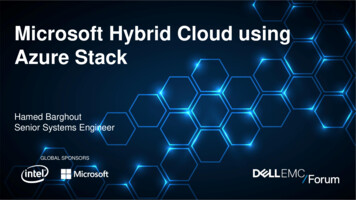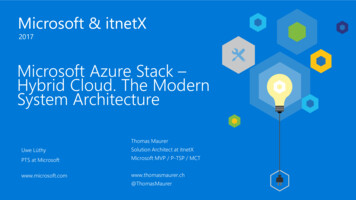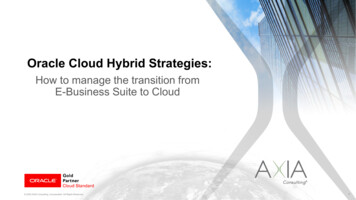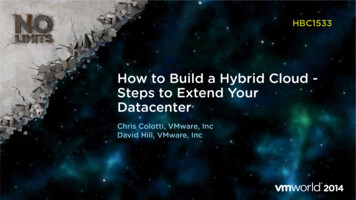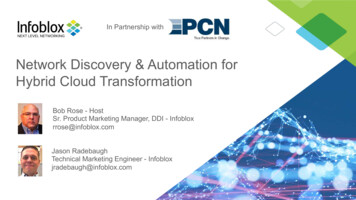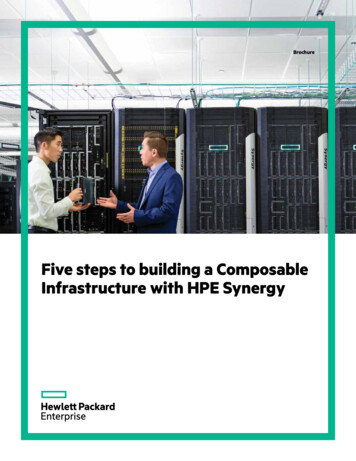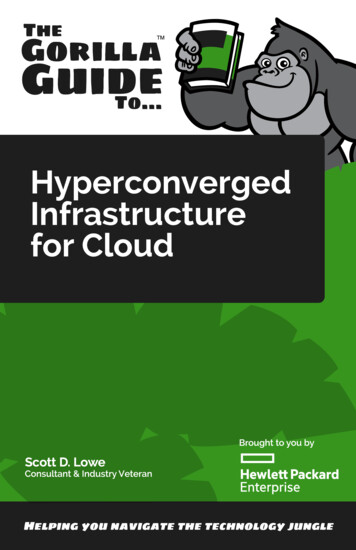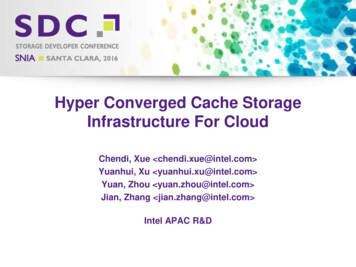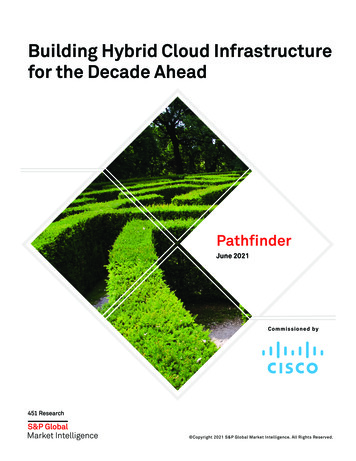
Transcription
Building Hybrid Cloud Infrastructurefor the Decade AheadPathfinderJune 2021C om m ission ed by Copyright 2021 S&P Global Market Intelligence. All Rights Reserved.
Pathfinder Building Hybrid Cloud Infrastructure for the Decade AheadAbout the AuthorEric HanselmanPrincipal Research AnalystEric Hanselman is the Principal Research Analyst at 451 Research, a part of S&PGlobal Market Intelligence. He has an extensive, hands-on understanding of abroad range of IT subject areas, having direct experience in the areas of security,networks, application and infrastructure transformation and semiconductors.He coordinates industry analysis across the broad portfolio of 451 Researchdisciplines, contributes to the Information Security and Cloud Native Channels, andis a member of the Center of Excellence for Quantum Technologies.The convergence of forces across the technology landscape is creating tectonicshifts in the industry, including 5G, SDN/NFV, edge computing and DevSecOps. Erichelps 451 Research’s clients navigate these turbulent waters and determine theirimpacts and how they can best capitalize on them. For more than 20 years, Eric hasworked with segment leaders in a spectrum of technologies, most recently as CTOof Leostream Corporation, a virtualization management provider. Prior to that, Ericguided security offerings for IBM and Internet Security Systems. At Wellfleet/BayNetworks and NEC, he was involved in the introduction of many new technologiesranging from high-performance image analysis to rollouts for IPv6.Eric holds a patent in image compression systems. He is also a member of theInstitute of Electrical and Electronics Engineers (IEEE), a Certified InformationSystems Security Professional (CISSP) and a VMware Certified Professional (VCP),and he is a frequent speaker at leading industry conferences. Eric majored inChemistry at Reed College. COPYRIGHT 2021 S&P GLOBAL MARKET INTELLIGENCE. ALL RIGHTS RESERVED.II
Pathfinder Building Hybrid Cloud Infrastructure for the Decade AheadExecutive SummaryThe dynamic nature of most business environments can place conflicting requirements on IT teams. They’reworking hard to find the resources to keep their businesses competitive, but they have to manage costs at thesame time, all while supporting an increasingly diverse set of applications. More organizations are deployinghybrid cloud architectures to achieve these goals, but not all of them are succeeding. Many face challenges inbringing their on-premises environments up to the same level of agility they can achieve with their off-premisescloud resources. That imbalance can cause them to make trade-offs in workload placement, creating additionalcomplexity in IT operations and limiting application development teams. Ensuring that the on-premises sideof a hybrid environment is built on a foundation that can support the full range of possibilities that the modernbusiness needs can be the differentiating factor in determining a successful outcome. Today’s infrastructurehas to be able to support a much greater scale, velocity and diversity of applications to stay competitive.Key Findings– Modern infrastructure has to support a complex mix of applications.– Competitive pressures require organizations to manage capacity flexibly and cost-effectively.– Hybrid operational efficiency requires coordination across resource realms.– On-premises infrastructure has to be able to perform as well as cloud to make hybrid models successful.– Many are making the hybrid journey without a formal strategy, increasing complexity and cost.– Reducing operational complexity is critical to achieving management effectiveness and efficiency forhybrid models. COPYRIGHT 2021 S&P GLOBAL MARKET INTELLIGENCE. ALL RIGHTS RESERVED.1
Pathfinder Building Hybrid Cloud Infrastructure for the Decade AheadIntroductionThe modern business is operating in markets that are buffeted by various forces that are difficult to plan for.Shifts in customer preferences and competitive position can seem constant. In order to succeed in such aturbulent world, organizations need to be nimble, and their technology resources can ensure that success.IT teams have to deliver infrastructure that can adapt quickly and scale, and optimize costs while doing so.These requirements have driven many organizations to deploy hybrid cloud environments, and while suchenvironments offer significant advantages, they also bring complexities that can raise costs and hamperoperations if not managed effectively. If their hybrid efforts are going to succeed, organizations need to ensurethat their on-premises resources don’t become a less-attractive or less-capable option. On- and off-premisesresources have to operate in harmony to support application development efforts that deliver greater numbersof applications with more varied requirements and do it at much greater speed. To achieve this will require abetter core infrastructure and operational improvements.The Accidental HybridThe first use of public cloud for many organizations was experimental. Small projects or individual efforts weretrials to see what it was and how it could be used. Today, most organizations have a deeper understandingof public cloud and are putting it to work in some form. The next stage in this journey is mastering the abilityto coordinate operations across cloud and on-premises environments, a hybrid cloud operational pattern.According to a recent 451 Research study, 58% of respondents said their existing or planned IT operatingenvironment is hybrid. That speaks to the needs that are driving hybrid adoption, which are many. COPYRIGHT 2021 S&P GLOBAL MARKET INTELLIGENCE. ALL RIGHTS RESERVED.2
Pathfinder Building Hybrid Cloud Infrastructure for the Decade AheadFigure 1: Enterprise Operating Environment, Current and in PlanStrategic Directions for Organizational ITHybrid IT environmentEntirely public cloudSiloed on- and off-premisesEntirely on-premisesCloud is not an important part of our IT strategy58%18%10%9%4%State of Hybrid ImplementationFormal strategy in place and actively executingDeveloping a planConsidering but no formal planNo strategy at present3%Don't know56%26%9%7%Q: Which of the following best describes your organization’s existing or planned IT operating environment?Base: All respondents (n 445)Q: Which of the following best describes the state of your organization’s strategy regarding hybrid IT?Base: Hybrid as the organizing principle of IT strategy (n 147)Note: In last year’s survey, we asked this question of all respondents, with 34% reporting ‘active execution’ on hybrid strategy. Thecomparable figure in this year’s survey is 41%.Source: 451 Research’s Voice of the Enterprise: Cloud, Hosting & Managed Services, Vendor Evaluations - Quarterly Advisory ReportThe modern IT environment is built from a large collection of applications, services, partners and capabilities.A web environment, for example, can include not only the content that’s produced, but an ecosystem oftechnologies from many providers that bind together product listings, e-commerce functionality, marketingdata, customer relationship management, inventory systems and security tools, among other things. Wherethat might once have all resided in an on-premises datacenter, it is now provided through on- and off-premisesinfrastructure. This shift has driven an expectation of hybrid operations and is changing IT operational models.The difficulty behind it is that these changes are often not fully planned out.The Voice of the Enteprise (VotE) study also asked those respondents who said they were operating in a hybridmode about the state of their hybrid implementations; the result is concerning. While there was improvementfrom the previous year’s results, there are still 42% who said that they don’t have a formal plan in place to guidetheir hybrid use, which indicates that they’re arriving at hybrid more by accident than by design. This could bedue to the incremental nature of the growth of cloud use – each new element is added for a specific projector requirement, but not coordinated through a larger plan. However, deploying hybrid cloud without a plan is arecipe for uncontrolled costs and escalating administrative work. COPYRIGHT 2021 S&P GLOBAL MARKET INTELLIGENCE. ALL RIGHTS RESERVED.3
Pathfinder Building Hybrid Cloud Infrastructure for the Decade AheadHybrid Cloud InfrastructureMindsets Have to ChangeIt’s not hard to see where traditional operating mindsets contribute to the problems that result in uncontrolledhybrid operations. IT teams used to build infrastructure around the applications that it was going to support.Large, monolithic applications came with hardware compatibility lists that specified what was required.Virtualization started to change that situation years ago, but the mindset and its effects persist for some.Continuing to build infrastructure with a project-only focus, rather than planning for infrastructure that cansupport an organization’s broader business goals, risks creating complexity and increasing costs. IT teams needto consider how the infrastructure that they’re building will serve them over the long haul and how adaptable itwill be to changing business and technology needs.Adaptability is critical to infrastructure investment decisions. The mix of applications and development patternsis under constant change as organizations look to adapt and compete. Fundamental changes in building blocks,in the shift from virtual machines to containers and onward to functional and serverless models are alreadystraining existing environments. As digitization moves forward, they’ll need to support not only greater volumesof data coursing through their systems, but also provide the means to accelerate the processing and analysisof that data. Artificial intelligence and machine learning (AI/ML) need GPU and FPGA accelerators to scale tothe heights required for rapid decision-making. All of this needs to be done with infrastructure that can flex andscale to meet these dynamic requirements.Hyperscale cloud providers master adaptability with scale that enterprises are challenged to meet on-premises.They can deploy volumes of servers with a wide variety of technologies and capacities and refresh them at thesame rate new techonlogies arrive. To reach the same level of adaptability without that scale, enterprises haveto leverage systems that use modularity to let them reconfigure and integrate new technology with the sameflexibility. It’s critical for enterprises to be able to put new processing options, with next-generation processors,and increased networking capacity, like 400Gbit optical links, to work without causing major disruption to theirdatacenters. By disaggregating the traditional server model into resources that can be pooled and reformed asneeded, they can support a wider set of use cases and application demands.The shift to hybrid strategic thinking is being driven by all of these factors. That same 451 Research VotE studylooked at use cases the respondents cited for pushing them forward to hybrid deployments. The leading usecase was cost optimization across on-premises and public cloud resources (cited by 50% of all respondents andby 60% who indicated that they were using more than one IaaS or PaaS provider). That’s a goal that is importantto carry through to guide infrastructure decision-making. Creating different resource cost options with on andoff-premises capacity is an important first step, but if they can’t be managed efficiently, that cost advantage willbe quickly consumed by the extra management overhead required to make it all work together. COPYRIGHT 2021 S&P GLOBAL MARKET INTELLIGENCE. ALL RIGHTS RESERVED.4
Pathfinder Building Hybrid Cloud Infrastructure for the Decade AheadFigure 2: Use Cases Driving Hybrid IT DeploymentCost optimization acrosson-premises/public cloud resources50%Extend the IT capacity of on-premisesinfrastructure without capital expense45%Off-site location for backup/disasterrecovery/business continuity34%Bring disparate IT environments togetherunder single management framework30%Workload migration amongdifferent environments as neededEnable workload components tooperate in different environmentsCentralized data repository for applications/businessprocesses running in different IT environmentsCompatible IT environments for all stagesof app development lifecycle60% of organizationsusing more than oneIaaS/PaaS provider(n 77)53% of organizationswith 1,000 employees(n 75)29%22%21%31% of organizationsusing GCP (n 29)18%Q: Which of the following use cases are driving your organization’s implementation of hybrid IT environments? Please select up to three.Base: Have or planning formal strategy for hybrid IT (n 125)Source: 451 Research’s Voice of the Enterprise: Cloud, Hosting & Managed Services, Vendor EvaluationsIt’s worth considering the state of enterprise infrastructure efficiency as part of the larger approach to hybrid.It’s an area where expectations of scale and agility have been notably lower than those of cloud providers, butthat is also often burdened with operational models that bear the legacy of traditional, segmented resourcemanagement. Without the ability to provision compute, memory, storage and networking in a composablefashion, an enterprise is limited in both flexibility and the speed and scale that it can accomplish.Organizations’ approaches to infrastructure management need to fully embrace cloud operational thinkingin their on-premises operations. It’s the next step in moving beyond the project-centric thinking that hasheld many back. It requires focusing on the flexibility of the provisioning process to deliver a wide range ofresource options and be able to do it in a highly flexible fashion. To effectively match up with cloud resources,on-premises resources need to be able to operate at similar speeds and orchestrate with the same tools.Automation and orchestration have to be in place to deliver the velocity and scaling needed. They’re technologiesthat can be force multipliers for IT administrators. They’re also the technologies that can leverage newer,disaggregated infrastructure platforms that give enterprises the ability to assemble resources with theflexibility modern applications demand. Requiring application development teams to use different meansto access different types of infrastructure locks in operational complexity that will slow them as well as thebusiness imperatives they support and increase development time and costs. COPYRIGHT 2021 S&P GLOBAL MARKET INTELLIGENCE. ALL RIGHTS RESERVED.5
Pathfinder Building Hybrid Cloud Infrastructure for the Decade AheadComplexity Has To Be TamedThe efficiency that hyperscale cloud providers have achieved comes from several aspects of their operations,but the most important is driving down management complexity. Enterprises need to keep this in mind as theylook at what’s required to master hybrid operational models. The 451 Research VotE study asked respondentswho have hybrid infrastructure in place how well it was delivering on their expectations. The vast majority werehappy with the ability to provision quickly, but the lowest-scoring option was management simplification, likelybecause one of the casualties of heading into hybrid without sufficient planning – the accidental hybrid state –has been management integration. Even though cost optimization was the leading use case, it only scored in themiddle of the pack for expectations. That’s an indication that enterprise goals aren’t always being met.Figure 3: Hybrid IT: Delivery on ExpectationsExceeds expectationsMeets expectationsFaster app scaling to meetchanging business requirements (n 168)Supports all stages of app lifecycle withcompatible environments in variousworkload deployment venues (n 165)Falls short of expectations63%17%11%9%Enables workload migration betweendifferent environments as needed (n 159)8%Brings disparate IT environments undera single management framework (n 174) 6%12%55%Enables centralized data repository forapps in different IT environments (n 169) 7%Cost optimization across dedicated/on-demand resource environments (n 160)Don't have this 0%21%Q: For each of the following intended outcomes, please indicate whether your hybrid IT environment is meeting, exceeding or falling short ofyour expectations.Base: Respondents with hybrid IT infrastructure in placeSource: 451 Research’s Voice of the Enterprise: Cloud, Hosting & Managed Services, Workloads & Key ProjectsFor organizations to achieve the cost and efficiency goals that hybrid offers, they need to reduce managementcomplexity. It’s also a tactic to address chronic skills shortages in IT teams. By putting integrated managementto work, they can reduce the need for specialized skills in each of the types of infrastructure they use, as well asput automation to work as a force multiplier for their administrative teams, and allow them to offer resources inthe forms development teams want to consume them. Whether that’s containers delivered with Kubernetes orapplications deployed with Terraform, IT teams can be ready to handle the demand. COPYRIGHT 2021 S&P GLOBAL MARKET INTELLIGENCE. ALL RIGHTS RESERVED.6
Pathfinder Building Hybrid Cloud Infrastructure for the Decade AheadManagement system deployment models place varying demands on administrative teams and on supportinginfrastructure. The traditional models, where management systems were deployed on-premises, weregeared toward the management of traditional infrastructure. They included a not inconsequential amount ofoperational irony. The systems that were meant to ease operational burdens came with their own operationalburdens. They needed hardware to support them that needed to be managed, as well as requiring managementthemselves. As organizations look to management systems for hybrid environments, they need to considerthe operational burden they’ll place on the teams running them. To the greatest extent possible, managementsystems need to support an extension of the processes and procedures that are in place while integrating withnew resources.Management systems that are delivered in a SaaS model can reduce some of the operational toil required ofadministrative teams. There is limited work to deploy them, and the upkeep is managed by the provider. Thereis an additional benefit in hybrid infrastructure, in that they can have more performant and reliable accessto cloud resources. SaaS models can also accelerate the velocity of innovation by enabling new functionalitywithout the need for the disruption and downtime that traditional system upgrades require. They can be onemore way to reduce operational complexity. COPYRIGHT 2021 S&P GLOBAL MARKET INTELLIGENCE. ALL RIGHTS RESERVED.7
Pathfinder Building Hybrid Cloud Infrastructure for the Decade AheadPutting Hybrid Infrastructureto WorkGetting to the level of infrastructure agility required to support the modern application development lifecycleisn’t trivial, but it’s mandatory for business success. Organizations struggle in a number of areas, but complexityis the predominant issue. New patterns of application development can be held back if existing infrastructureand operations are not up to the task. In a recent 451 Research VotE DevOps study, technical complexity wasthe leading reported barrier to advancing to a DevOps development pattern, one that’s representative of moreagile processes. Complexity was a greater concern than cost, indicating that spending won’t fix the problem.Infrastructure has to be standardized, adaptible and automated to make it simpler for application developmentteams to consume. It has to be able to be reconfigured to fit new demands and new technologies, and it has toget to a cloud operating model to gain the speed and efficiency those teams demand. Hybrid infrastructure canoffer the c
1 day ago · management. Without the ability to provision compute, memory, storage and networking in a composable fashion, an enterprise is limited in both flexibility and the speed and scale that it can accomplish. Organizations’ approaches to infrastructure management need to fully embrace cl
